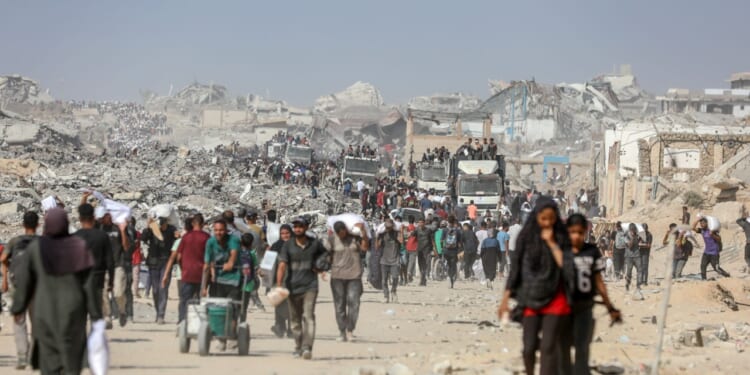The Palestinian Authority is the only viable organization that can replace Hamas in governing the Strip.
After the ceasefire in Gaza, the first phase of President Trump’s Gaza peace plan is nearing completion. All surviving Israeli hostages have returned home after two hellish years in Hamas’s tunnels; the remains of the dead hostages are being retrieved—too slowly, but with the dignity their families deserve. In return, Israel released 250 Palestinian prisoners serving long prison sentences for violent attacks and 1,700 more detainees. More than two years after Hamas’s October 7, 2023, assault on Israel, the worst and most vicious fighting in the decades-long Israeli-Palestinian conflict has stopped, giving both exhausted and traumatized societies a measure of respite.
The second phase hinges on Hamas’s disarmament. Only after verifiable demilitarization will the IDF withdraw from Gaza and let reconstruction of the razed and battered Strip begin in earnest. The plan calls for the deployment of an international stabilization force, while a temporary, technocratic Palestinian administration manages day-to-day affairs.
After such bitterness, Israelis and Palestinians both need and deserve a genuine shot at a more hopeful future. However, moving beyond phase one will be extremely challenging. Israel should not resign itself to Hamas rule over Gaza but must reconcile itself to the rule of the Palestinian Authority. The core challenges are threefold: ensuring Hamas’s disarmament, recruiting a credible stabilization force, and mobilizing donors for reconstruction in an environment still shaped by Hamas’s coercive control and IDF presence.
Recent US messaging reflects this reality. At an October 21 press conference, Trump’s envoy Jared Kushner said, “No reconstruction funds will be going into areas that Hamas still controls.” In other words, Gaza will be functionally divided unless Hamas disarms—one Hamas-free zone where reconstruction proceeds and another Hamas-ruled zone left frozen and largely unreconstructed.
Trump has said that if Hamas does not disarm, Israel has his blessing to “finish the job” militarily. The binary decision reflects a political reality: neither Arab states nor the international stabilization force will fight Hamas on Israel’s behalf. All parties agree on this point. Israel doubts the force’s willingness to use force effectively and fears that if it doesn’t confront Hamas, nobody will. Moreover, Israel worries about inadvertent clashes in which international forces will be interposed between the IDF and Hamas—an obvious recipe for friction. What is clear is that the IDF is not leaving Gaza until Hamas is subdued.
Indeed, paragraph 16 of the Trump plan clearly lays out the dynamic: “As the ISF establishes control and stability, the IDF will withdraw based on standards, milestones, and timeframes linked to demilitarization agreed upon by the IDF, ISF, the guarantors, and the United States.” In practice, the international force will likely verify gains and perhaps provide border security along the “yellow line” in the 53 percent of Gaza where Hamas is not dominant—less an expeditionary force to break Hamas than a framework to lock in territorial control. Others wonder whether the ISF will even function as an advisory body, let alone in a limited operational role.
This begs the question: What could provide security inside the yellow line and, over time, even in parts of Gaza where Hamas remains entrenched? One answer—imperfect but plausible—is the Palestinian Authority Security Forces (PASF) working with the IDF. Despite their shortcomings, these forces have over three decades of experience in security coordination with the IDF in the West Bank. Though often criticized by both Israeli and Palestinian publics, they are still effective at suppressing militants and sharing intelligence.
PASF involvement would signal to the long-suffering Gazans that Palestinians can indeed hold key security roles and deepen their own self-governance. Critically, Hamas has repeatedly stated it will not relinquish its weapons except “within a comprehensive Palestinian national framework” or until “full national rights are restored.” This positioning—however rhetorical—means PA involvement may be the only mechanism that offers Hamas a face-saving exit from armed struggle, framing disarmament as a transition to Palestinian unity rather than surrender to Israel.
Involving the PA has additional advantages. First, it is the only non-Hamas institution with any administrative capacity in Gaza. Israeli-PA cooperation that extends far beyond security in the West Bank still exists in Gaza. Before 2007 and since, the PA has remained a major employer in health, water, energy, and monetary policy—precisely the interfaces Israel and donors need to scale humanitarian response and reconstruction. Moreover, several names being floated for the technocratic committee for interim rule over Gaza are linked to the PA and respected by their Israeli counterparts for their technical competence on these issues.
Second, after October 7, the PA’s standing in Arab capitals improved relative to Hamas. The Emiratis, Egyptians, Jordanians, and Saudis will not fund reconstruction absent Palestinian self-governance. The same is true for the European governments. While Arab and European states do not expect this Israeli government to endorse a two-state solution, they do expect the PA to participate in the future direction of Gaza, and they do expect a path that keeps alive a political horizon of hope. Egypt, like other Arab states, has conditioned its involvement in phase-two activities on an explicit invitation from the PA.
A formal PA invitation for international involvement would also carry significant legal and diplomatic weight; it could facilitate and provide diplomatic legitimacy to the passage of a UN Security Council resolution authorizing the stabilization force under Chapter VI (consent-based peacekeeping) or Chapter VII (enforcement measures with binding authority). Such a resolution would provide clear rules of engagement, and potentially stronger mandates for the force—critical elements that ad hoc arrangements often lack.
Third, the PA’s desire to expand its Gaza role is the best leverage for long overdue reforms urged by Washington, Arab governments, and Europe, and set as a precondition by Israel.
Two obstacles loom. First is time: Gaza’s humanitarian crisis is immediate, and Hamas can quickly reassert its rule over Gaza, while PA reforms are slow. Second is Prime Minister Benjamin Netanyahu’s and his coalition’s opposition to the PA, fearing that successful Palestinian governance could open the door to two-state talks.
Netanyahu has repeatedly declared that he wants Gaza to become neither “Hamastan” nor “Fatahstan” (the party dominating the PA), viewing both as hostile in different degrees. Netanyahu argues that the PA has targeted Israel in international forums and eschewed normalization. Even beyond the government, especially after October 7, many Israelis are convinced that Hamas will outmuscle the PA, just as Hamas did two years after Israel’s withdrawal from Gaza in 2005. These tensions can be managed if responsibilities are phased and benchmarked, with Israeli security primacy during transition but growing Palestinian control as competence is demonstrated.
This is the reason that Trump’s plan assumes that the PA will not take charge of Gaza initially, but could assume governing and security responsibilities over time after instituting sweeping and durable reforms. That sequencing aims to reconcile the Israeli skepticism with international demands for Palestinian self-governance.
And while the gap between Israel and the Arabs and the Europeans is serious, it is not unbridgeable. Virtually no one wants Hamas to rule Gaza, and indeed, it is critical to note that the Saudis and Emiratis are linking their support to the disarmament of Hamas. A workable compromise might emerge in practice rather than through public declarations. We could see Gazans trained to PA standards without PA insignia and salaries paid directly by Ramallah. This model separates the stigma associated with the PA rule from the functionality of PA-linked institutions.
In civilian spheres as well, PA involvement in practice—rather than the PA in formal rhetoric—could anchor service delivery without triggering a maximalist political backlash. This can take many forms, as has been the case prior to October 7—for example, the PA can resume its responsibility as part of the Ministry of Health for referrals to treatments outside of Gaza and medicine procurement; handling customs as part of the Civil Committee; fixing water and electricity infrastructure under the Palestinian Water Authority; and providing the banking framework for vouchers and other financial transactions conducted by UN agencies, as part of the Monetary Authority.
Realism dictates compromise. No actor will achieve its maximal aims. Israel will have to accept a PA-linked role in running Gaza; the PA will have to accept that its initial remit will be only partial and contingent. The quid pro quo is measurable performance: as governance in Gaza improves and security benchmarks are met, responsibilities expand. This is not a romantic aspiration. It is a transactional and gradual process—and that is precisely why it may work.
The PA today is like a car without wheels: it cannot drive Gaza out of the post-October 7 morass. But wheels can be added—reforms that build credibility, training that professionalizes the PA’s security forces, and service delivery that tangibly improves daily life for suffering Gazans. With each milestone, the PA gains a larger role, international donors gain confidence, Israel gains a more stable frontier, Gazans gain a path out of limbo, and Palestinians everywhere regain agency that could help establish a political horizon.
This is not the sweeping transformation some demand. But it is the kind of incremental, benchmarked progress that has the best chance of surviving in an unforgiving region. Israel must make a major shift in mindset: the PA, which Netanyahu now defines as part of the problem, should become a key part of the solution.
About the Authors: David Makovsky and Shira Efron
David Makovsky is the Ziegler Distinguished Fellow at The Washington Institute and director of the Koret Project on Arab-Israel Relations. He is also an adjunct professor in Middle East studies at Johns Hopkins University’s Paul H. Nitze School of Advanced International Studies (SAIS) and president of the board for the National Library of Israel’s U.S. affiliate (NLI-USA). In 2013-2014, he worked in the Office of the U.S. Secretary of State, serving as a senior advisor to the Special Envoy for Israeli-Palestinian Negotiations.
Shira Efron is the RAND Corporation’s distinguished chair for Israel Policy. A leading expert in Israeli and Middle Eastern affairs, Efron brings two decades of experience in policy analysis and research, having previously led RAND’s Israel Program from 2016 to 2022. Most recently, Efron served as director of research and the Diane and Guilford Glazer Foundation senior fellow at the Israel Policy Forum.
Image: Anas-Mohammed / Shutterstock.com.

















